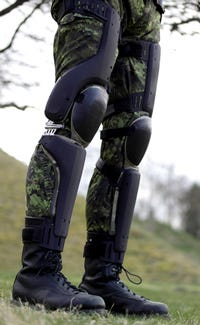5 Things You Need to Know About Energy Harvesting
January 28, 2015
|
Max Donelan |
Energy harvesting seems like a pretty common sense idea: medical devices powering themselves from the human bodies they serve. But it really isn't that simple, says Max Donelan, PhD, associate professor of biomedical physiology and kinesiology at Simon Fraser University in Vancouver, British Columbia. There are plenty of lessons to be learned.
Donelan should know. He is a scientific adviser to a Simon Fraser spinout called Bionic Power that he helped start in 2007. The company's PowerWalk M-Series--developed in collaboration with the Canadian Forces and the U.S. Army-- resembles an athletic knee brace and weighs nearly 2 pounds per leg. The PowerWalk can generate an average 12 W when the user is walking comfortably: enough energy to charge four mobile phones after a hour's walk.
Here are five important lessons that Donelan has learned about energy harvesting.
1. There's a Lot of Power Available from the Human Body.
Human beings have so many moving parts that there is plenty of opportunity, Donelan says.
A person on an elliptical or tandem bicycle can generate 200 W of mechanical energy, about half of which can be captured by a standard electromagnetic generator, according to Donelan.
See Donelan discuss biomechanical energy harvesting for portable devices at MD&M West, in Anaheim, CA, February 10-12, 2015. |
2. But It Makes a Lot More Sense 'Off the Grid.'
Using exercise power to light a gym is generally a bad idea, though, Donelan says. Why? Electricity is still relatively cheap--about 10 cents per kWh where Donelan lives in Canada. A person would have to pedal a bicycle for 10 hours to produce 10 cents worth of electricity.
"If you can plug into the grid, you should," Donelan says.
Where energy harvesting makes a lot more sense is off the grid. The same 10 cents per kWh of electricity in Canada turns into $1,600 after its stored in a battery and shipped to a war zone so that soldiers can power equipment in the field, Donelan says.
That doesn't even count the risk to human life that goes with driving the batteries through a war zone. A device such as the PowerWalk, then, makes a great deal of sense in the military. Donelan also sees uses for medical professionals in development countries where power is not reliable. Health professionals wearing the PowerWalk could use the electricity to keep vaccines cold or charge smartphones that provide prenatal instructions to expecting mothers.
There are plenty of wearable devices that could benefit.
The holy grail is to use energy harvesting to power medical devices inside the human body--which is another version of being "off the grid."
"Delivering electricity to Afghanistan is a lot like delivering electricity inside the human body," Donelan says.
3. It Should Not Take Away from a Person's Time.
Time is a significant barrier when it comes to creating a usable energy harvester. Requiring someone to pedal on a stationary bike for 8 hours is not doable.
Donelan jokes that a rechargeable flashlight should only be shaken enough that there's enough light to find a candle and matches in the house.
"If you can, it is best to keep the energy harvesting in the background," Donelan says.
|
Bionic Power's PowerWalk M-Series, as shown on the company's website |
4. And It Should Avoid Increasing a Person's Efforts.
It has been about a year since news came out about a super-thin silicone-encased, bendable energy harvester that can be affixed to a beating heart. Flexible electronics pioneer John Rogers and colleagues have placed the device on the surface of hearts beating inside anesthetized cows and sheep, demonstrating that it can produce up to 1.2 ?W/cm².
But in designing the energy harvester, it was important to avoid damaging the heart, PhD, of the University of Illinois-Champaign, told Qmed/MPMN last year.
The more external pressure the energy harvester places on the heart, the more electricity it will produce. But it is also more likely to cause arrhythmias as other damage that defeat the purpose for having the device there in the first place. "It requires very careful attention to how the device is interacting with the organ it is mounted on," Rogers said.
Donelan agrees that energy harvesters can defeat their purpose if they restrict movement. For example, he didn't see much point in an energy harvester that wraps around the chest to generate electricity off breath movements. "It's going to make it harder for you to breath," Donelan said.
A patch that generates a few mW, however, could power a chip sensor with minimal effort from the body.
Better yet is to capture energy from movement in a way that actually benefits movement. Bionic Power accomplished this with the PowerWalk by having it generate electricity not from locomotion in the legs, but rather from "braking motion" in the legs meant to control gate or keep someone upright. The technology uses principles similar to regenerative braking in hybrid cars. Much of the development work involved creating the computer programs and algorithms that ensured the PowerWalk's electromagnetic generator's magnets only kicked on when such braking motion was taking place.
5. Use the Body's Own Mass Versus Outside Mass.
PowerWalk is using resistance from the body's own mass to produce electricity--a strategy that Donelan prefers because devices that use outside mass on the body often need heavy weights to produce larger amounts of electricity.
Donelan is impressed with a Wayne, PA-based company called Lightning Packs, which produces backpacks able to produce 12 to 15 W while the wearer is walking with 50 pounds. The packs could be great for soldiers or hardcore hikers, but Donelan acknowledges that 50 pounds would be a hard sell for an average person walking around with a backpack.
On the opposite side of the scale, self-winding wrist watches produce almost no discomfort, but the watches don't need much electricity to operate.
Chris Newmarker is senior editor of Qmed and MPMN. Follow him on Twitter at @newmarker.
Like what you're reading? Subscribe to our daily e-newsletter.
About the Author(s)
You May Also Like



